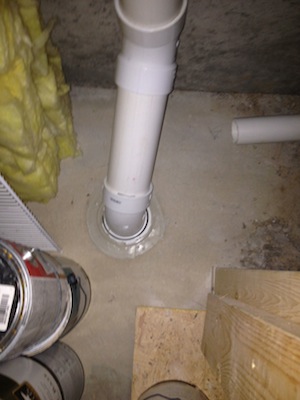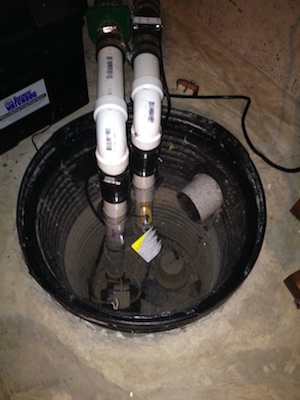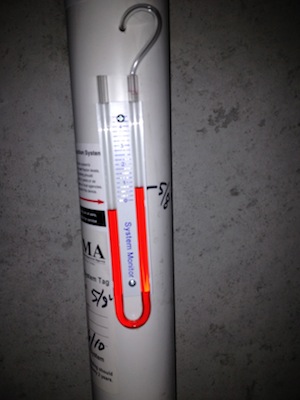Radon Mitigation
- What is Radon Mitigation?
- What Are the Action Levels in Other Countries?
- How Much Does Radon Mitigation Cost?
- Should I Hire a Certified Radon Contractor to do the Job?
- What Methods are Used to Remove Radon from a Home or Residence?
- How Well Does Radon Mitigation Work?
- Do I Have to Hire a Contractor or Can I Install a Mitigation System Myself?
- What are Some Requirements for the Mitigation System?
- Is Radon Mitigation Guaranteed?
- How Often Should You Test the Radon Levels in Your Home after a Mitigation System is Installed?
- Are Digital or Electronic Radon Monitors More Accurate?
- Common Radon Mitigation Methods – Comparison
Radon is very dangerous when it collects inside a home or residence. Those who are exposed to higher levels of radon for an extended period of time will have an increased risk of contracting one of many different forms of lung cancer. Worse yet, radon is colorless, odorless, and tasteless which means there really is no way to tell if you’ve been exposed. That is, of course unless you test the radon levels in your residence.
A lot of resources identify how to test for radon, how to know what levels are bad and when to take action. Unfortunately, many of them don’t detail the mitigation process in-depth. That is exactly what we’re going to do here.
In the event that you’ve come across elevated radon levels in your home, you can visit this page to find out where to go next. We’ll also outline what to do after you’ve had a radon mitigation system installed – because it doesn’t just stop there.
Let’s get started.
What is Radon Mitigation?
Radon mitigation is essentially any process – of which there are several – used to remove concentrated levels of radon from a home, residence or business. Radon is a very dense gas, which means once it enters a residence it can collect in large quantities over time. There are a couple of different ways radon can enter a home, such as through the water supply, or from the soil underneath the foundation. However, the primary method through which radon enters a home is the soil supply. It can seep through cracks or gaps in the foundation, walls and floors.
Radon mitigation involves filtering the radon gas out of a home or incoming water supply. There are many different ways this can be done, most of which are actually not very costly or time-consuming. It seems to be a common misconception about radon mitigation that it is very expensive. It does cost a bit, but compared to the damage radon causes when left unhindered the cost is always worth it.
The current action level here in the US, as set by the EPA is 4.0 pCi/L. That means any residence that has a radon level at or exceeding that amount should have a radon mitigation system installed immediately.
What Are the Action Levels in Other Countries?
Canada recently lowered their action level to 200 Bq/m3 which is equal to 5.4 pCi/L here in the US. Currently, Australia, Ireland, Sweden and the UK also use 200 Bq/m3 as the recommended action level. To add to that, the World Health Organization recommends that radon levels be reduced to less than 100 Bq/m3 which is equal to about 2.7 pCi/L.
It is highly unlikely that the US EPA will raise the recommended action level from its present 4.0 pCi/l level (150Bq/m3) to 5.4 pCi/L. The current action level is harmful enough to those who are exposed to such levels over an extended period of time. Anything higher would only cause more health issues in the long run for many who follow the guideline.
How Much Does Radon Mitigation Cost?
Depending on the radon mitigation method used along with applicable equipment, the mitigation process can cost anywhere from about $1,000 up to about $3,000. It also depends on whether or not you hire a certified contractor to complete the job.
Because there are many different ways to remove radon, it’s difficult to put an exact price on the process.
Call now for a free Radon Testing/Mitigation Quote
Toll Free: 1-800-299-3578
Or fill out our contact form:
Should I Hire a Certified Radon Contractor to do the Job?
Obviously, whether or not you hire a professional to complete the job is up to you. We would certainly recommend doing so. Radon contractors generally know a great deal about radon itself, as well as the mitigation process and methods that can be used. In most cases, they will be able to recommend the ideal method for your home. This is very important, because the method used will be determined mainly by the design of your residence. In particular, the layout of the foundation and materials that were used to build the home will affect which mitigation process is used.
What Methods are Used to Remove Radon from a Home or Residence?
As previously mentioned, the ideal method is going to be determined by the design and layout of your home. We certainly recommend hiring a professional contractor to aid in the process. Radon mitigation contractors will generally assess your residence and approach the process appropriately.
There are three basic types of foundations for a home, but a home can use multiple designs: basement, slab-on-grade, or crawl space. In homes with a basement or slab-on-grade foundation design, one of the following mitigation methods can be used: subslab suction (most common), drain-tile suction, sump-hole suction and block-wall suction. Sub-slab suction is actually one of the most common and most effective radon reduction methods. It involves running suction pipes below the floor or foundation directly into crushed rock or soil. The system basically vents out the radon gas before it can travel anywhere else. Most modern homes will be outfitted with a sub-slab system provided the foundation allows for it. The average system costs about $1500 to put into place.
Another method involves a device called a heat recovery ventilator (HRV), or air-to-air heat exchanger. It essentially creates ventilation to the outside by introducing fresh air into a residence, cooling or heating the new air at the same time. HRVs are actually more effective in confined areas like a basement, and must only be used when radon levels are well below 10 pCi/L. Depending on the size of the device HRVs can cost anywhere from $600 all the way up to $1500. Obviously, the more powerful the device the higher the cost.
In a crawl space type foundation, submembrane suction is generally used to remove radon. It involves placing a plastic sheet or tarp over the earth floor, and venting the radon beneath with a pipe and fan system.
Additional radon mitigation techniques include the following - effective mitigation levels are also listed where applicable:
Radon Mitigation Techniques
- Subslab suction – 50 to 99 percent
- Passive subslab suction – 30 to 70 percent
- Draintile suction – 50 to 99 percent
- Block wall suction – 50 to 99 percent
- Sump hole suction – 50 to 99 percent
- Submembrane depressurization (crawlspace) – 50 to 99 percent
- Natural ventilation (crawlspace) – 0 to 50 percent
- Seal radon entry locations – N/A
- Home pressurization – 50 to 99 percent
- Natural ventilation – N/A
- Heat recovery ventilation – N/A
- Private well water aeration – 95 to 99 percent
- Private well water granular carbon (GAC) – 85 to 99 percent
You may or may not choose to seal your home better, but it should be noted that this will not reduce existing radon levels. Instead, sealing a home will only make a radon mitigation system more effective and should help prevent future gas from seeping in. It should never be used as a single method in radon reduction strategies. However, a contractor may recommend sealing off gaps and cracks in floors, walls and the foundation. If the radon levels are dangerous and the mitigation system doesn't seem to be helping as well as it should, this may be a suitable solution.
Finally, once a radon mitigation system is in place you must monitor and maintain it. It is an important part of the radon mitigation process even though it’s considered an extra step. If the system ceases to ventilate the radon properly the levels will increase all over again.
How Well Does Radon Mitigation Work?
It depends on the system implemented and how high the radon levels are in the residence. Most of the time a properly configured radon mitigation system will help decrease elevated levels, and will also keep future levels below 2 pCi/L at the most. Any kind of mitigation or ventilation system is going to lower the overall radon levels in a residence, so in quite a few cases it can be considered a surefire thing. Of course, if the the system is installed improperly than it could potentially do more harm than good depending on where the radon is being ventilated.
Systems that use fans to remove radon gas from a home are the most effective. However, it should be noted that running such a system would also increase a monthly electric bill.
In most states, the local radon department or the EPA require a post mitigation test, which must be completed within thirty days after a system has been activated. Not all states have such a law in place so you’ll have to check with your local department. If this is required in your state, a certified tester or sometimes even the contractor you previously hired can perform the retest.
Do I Have to Hire a Contractor or Can I Install a Mitigation System Myself?
While we certainly recommend hiring a certified radon professional to do the job, you can install a mitigation system yourself. There are several companies and brands out there that specifically offer DIY radon mitigation kits. In some states it is still required for a certified mitigation inspector to take a look at the system before or after it is installed in a home – you’ll have to check with local departments.
Many of the radon mitigation techniques listed can be easily put into place by a homeowner without the help of a professional. That being said, what you choose to do with your own home is your business.
What are Some Requirements for the Mitigation System
The most significant requirement is that the radon ventilation pipe must release the gas above the roof line of a home. There are several reasons for this, one of which is because at the point of exit the radon levels can number in the thousands of pCi/L. If you do not ventilate such dangerous substances above roof level, there is a possibly that younger children or someone else may come into contact with the ventilation pipe.
In most cases, the fan must actually be installed in the attic well above the basement level. If this is done a separate piping system will be used to pass air through the necessary spaces.
Is Radon Mitigation Guaranteed?
As we stated above, it depends on whether or not the system is installed properly. A poor mitigation installation could see the radon ventilating into other areas of a home. In extreme cases, it could end up not working at all. That is the biggest reason we recommend hiring a qualified professional to handle the task.
Since radon is so dense, it ends up collecting in large quantities usually at the lowest levels of any home – such as a basement. A proper ventilation system will help suck up the radon and spit it out elsewhere, keeping the interior environment of a residence safe and healthy.
The short answer is that no, radon mitigation is not always a guaranteed solution. However, if the radon levels in your residence are elevated then you will surely see a drop after putting a mitigation system in place.
The effectiveness of a radon mitigation system can decrease over time if the proper maintenance is not done. It’s also worth noting that even with a mitigation system in place homeowners should still constantly monitor radon levels in their home. We would recommend installing a digital radon detector somewhere in the home.
How Often Should You Test the Radon Levels in Your Home after a Mitigation System is Installed?
Regardless of whether or not a mitigation system is in place in your home, you should follow through with the recommended testing schedule as described by the EPA. At the very least, that means you should test the radon levels in your home twice a year. If there are any significant changes in your home such as a renovation, or you change the level of your home that you are living on you should also run another test. It’s always recommended that you start with a short-term test and if the levels are elevated, you continue with a long-term test. However, any test – provided it’s done in a safe and accurate manner – will be suitable.
We recommend installing a digital radon detector in your home after a mitigation system has been installed. This will allow you to constantly monitor the levels in your residence. Also, if the levels reach a dangerous and harmful limit the detector will sound an alarm alerting you immediately of the problem.
If you do decide to install a radon detector, it’s a good idea to place it in the lowest level of your home. It’s actually a much better idea to place it in the basement, if that’s where the mitigation system is in place. However, never place a detector or testing vials anywhere near the radon ventilation area – that is where the ventilation duct drains the radon from the home. Always keep it at least twenty to thirty feet away from such an area.
Are Digital or Electronic Radon Monitors More Accurate?
Yes, digital and electronic radon monitors are almost always more accurate than any passive testing system or kit. Many of them give real-time monitoring stats, by measuring radon levels continuously every hour. There are some long term radon monitors out there however, such as the new Pro-Series 3 radon monitor. The aforementioned device does not give radon measurements by the hour, and instead tracks the continuous long term average. In other words, it gives you an accurate reading of the average radon level in your home over an extended period of time. The latter device can be considered a unique form of long-term test.
Common Radon Mitigation Methods – Comparison
See our Radon Mitigation Techniques comparison chart for more information on the available methods.



